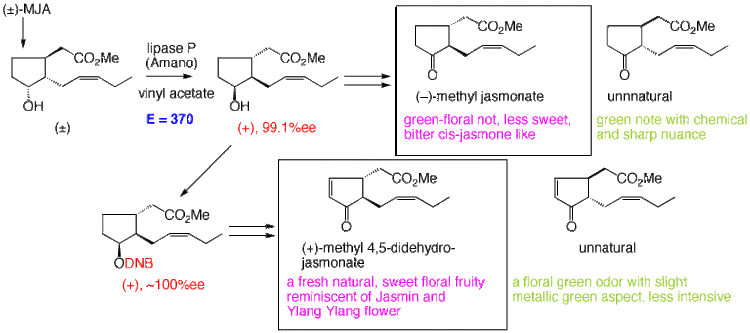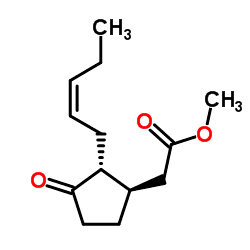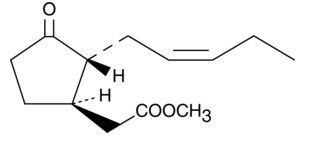Molar mass 224.3 g/mol | Appearance Colorless liquid | |
 | ||
Methyl jasmonate (abbreviated MeJA) is a volatile organic compound used in plant defense and many diverse developmental pathways such as seed germination, root growth, flowering, fruit ripening, and senescence. Methyl jasmonate is derived from jasmonic acid and the reaction is catalyzed by S-adenosyl-L-methionine:jasmonic acid carboxyl methyltransferase. Plants produce jasmonic acid and methyl jasmonate in response to many biotic and abiotic stresses (in particular, herbivory and wounding), which build up in the damaged parts of the plant. The methyl jasmonate can be used to signal the original plant’s defense systems or it can be spread by physical contact or through the air to produce a defensive reaction in unharmed plants. The unharmed plants absorb the airborne MeJA through either the stomata or diffusion through the leaf cell cytoplasm. An herbivorous attack on a plant causes it to produce MeJA both for internal defense and for a signaling compound to other plants.

MeJA can induce the plant to produce multiple different types of defense chemicals such as phytoalexins (antimicrobial), nicotine or proteinase inhibitors. MeJA activates the proteinase inhibitor genes (a defensive reaction within plants) through a receptor-mediated signal transduction pathway. The proteinase inhibitors interfere with the insect digestive process and discourage the insect from eating the plant again.

MeJA has been used to stimulate traumatic resin duct production in Norway spruce trees. This can be used as a defense against many insect attackers as a type of vaccine.

MeJA is also a plant hormone involved in tendril (root) coiling, flowering, seed and fruit maturation. An increase of the hormone affects flowering time, flower morphology and the number of open flowers. MeJA induces ethylene-forming enzyme activity, which increases the amount of ethylene to the amount necessary for fruit maturation.

Increased amounts of methyl jasmonate in plant roots have shown to inhibit their growth. It is predicted that the higher amounts of MeJA activate previously unexpressed genes within the roots to cause the growth inhibition.

Methyl jasmonate induces cytochrome c release in the mitochondria of cancer cells, leading to cell death, but does not harm normal cells. To be specific, it can cause cell death in chronic lymphocytic leukemia (CLL) cells taken from human patients with this disease and then treated in tissue culture with methyl jasmonate. Treatment of isolated normal human blood lymphocytes did not result in cell death

